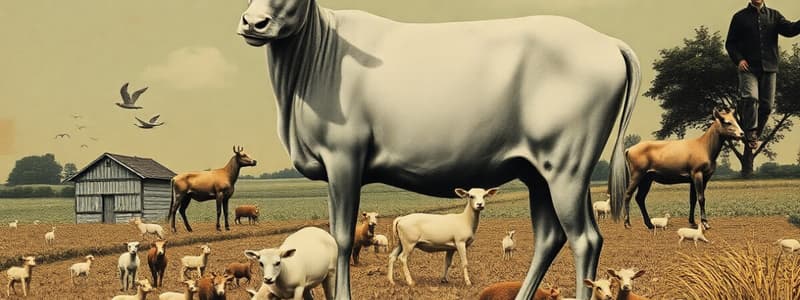Podcast
Questions and Answers
What was the primary reason for the shift from hunter-gatherer societies to agricultural societies?
What was the primary reason for the shift from hunter-gatherer societies to agricultural societies?
- A decrease in the population of wild animals.
- The invention of agriculture itself.
- A change in climate leading to a longer growing season. (correct)
- The discovery of new tools and technologies.
Which of the following is NOT a direct consequence of the agricultural revolution?
Which of the following is NOT a direct consequence of the agricultural revolution?
- The rise of civilizations.
- The development of specialized labor.
- The establishment of permanent settlements.
- The increase in nomadic lifestyles. (correct)
What is the significance of the domestication of animals in the context of the agricultural revolution?
What is the significance of the domestication of animals in the context of the agricultural revolution?
- It allowed humans to explore new territories for resources.
- It provided a way to control animal populations for hunting purposes.
- It ensured a more reliable source of food, clothing, and tools. (correct)
- It created a more organized system for trading animal products.
How did the "slash and burn" agricultural method contribute to the development of agriculture?
How did the "slash and burn" agricultural method contribute to the development of agriculture?
Which of the following is NOT considered a tool of the agricultural revolution?
Which of the following is NOT considered a tool of the agricultural revolution?
How did the agricultural revolution change the way humans interacted with their environment?
How did the agricultural revolution change the way humans interacted with their environment?
What was the primary reason for the invention of tools like hoes, shovels, and sickles during the agricultural revolution?
What was the primary reason for the invention of tools like hoes, shovels, and sickles during the agricultural revolution?
Flashcards
Hunter-Gatherers
Hunter-Gatherers
Early humans who lived by foraging for food.
Domestication of Animals
Domestication of Animals
The process of breeding animals for food and other products.
Agricultural Revolution
Agricultural Revolution
A significant shift from hunting-gathering to farming.
Spilled Grain
Spilled Grain
Signup and view all the flashcards
Slash and Burn Agriculture
Slash and Burn Agriculture
Signup and view all the flashcards
Growing Season
Growing Season
Signup and view all the flashcards
Agricultural Tools
Agricultural Tools
Signup and view all the flashcards
Study Notes
The Agricultural Revolution
- Early humans were hunter-gatherers, nomadic, constantly searching for food (plants and animals)
- Around 8,000 BCE, the climate warmed, glaciers melted, leading to a longer growing season
- Animal Domestication: Humans began breeding animals for food, clothing, and tools (like needles, harpoons). This provided a more reliable food source than hunting
- Agriculture Invention: Humans noticed spilled grain sprouting, leading to the concept of intentional planting of crops. This shifted human lifestyle from food gathering to food production.
- Agricultural tools: The need for farming tools like hoes, shovels, and sickles arose alongside the development of agriculture
Slash and Burn Agriculture
- Early farmers used fire to clear forests for more farmland.
- Slash and burn methods create poor soil, forcing farmers to relocate frequently.
Studying That Suits You
Use AI to generate personalized quizzes and flashcards to suit your learning preferences.




